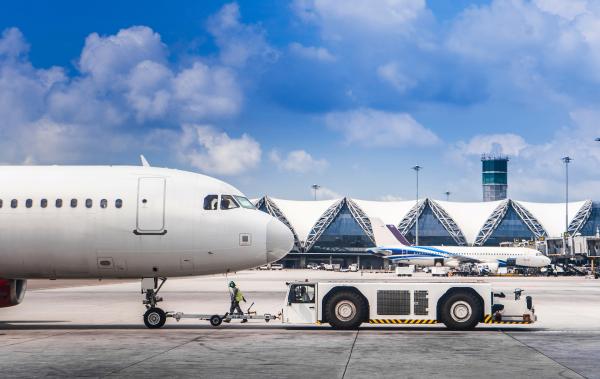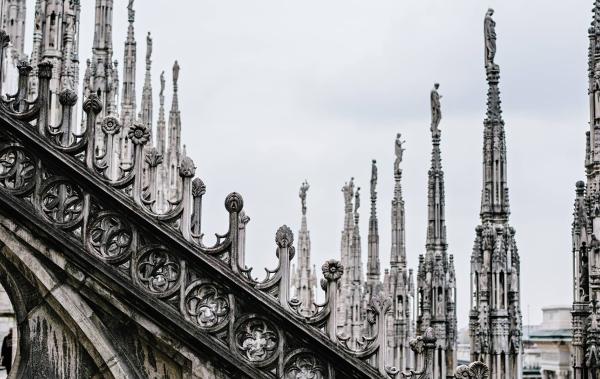From asphalt to AI
Responsible finance, Growth stories
From asphalt to AI
-
26 May 2021
-
Real Assets
-
Infrastructure
Reading time: 13 minutes
Welcome to Entrepreneurial Journeys, a podcast from Ardian for anyone curious about where growth is happening around the world. Each week, we speak to the people behind innovative companies building the future. I’m your host, Portia Crowe.
Is there anything more frustrating than being caught in a traffic jam? You’re in a rush, and your daily commute will not take its usual 20 minutes, but 45 minutes. But highway congestion is not just a problem for us as individuals — it also hurts the environment, and can lead to accidents. What if there was a way to reduce road traffic, and carbon emissions, by encouraging car sharing — using data and AI?
In this episode of Entrepreneurial Journeys, we speak to executives from two companies working together to do just that.
Ascendi is a 20-year-old Portuguese market leader in motorway operation, maintenance, and toll infrastructure owned by Ardian Infrastructure. The company is at the forefront of automized, free-flow motorway tolling, in which drivers do not need to stop and pay but can continue driving. Last year, Ardian team introduced Chief Business Development Officer Miguel Martin to Quentin Barenne, co-founder of French company, Wintics, which uses data collected from video cameras to analyse mobility flows through its proprietary software. Together, they are working to develop new tolling systems that could encourage drivers to use more fuel-efficient vehicles, and car share.
Martin and Barenne run two very different companies — one, a pure European infrastructure player, the other, a new solution using AI for mobility analysis — but they share the common goals of reducing carbon emissions, offering value-added services to drivers, improving motorway safety — and keeping ahead of developments in the mobility market.
It’s early days, but the two partners have big plans and common objectives to anticipate the future of mobility, while tackling the issues of road safety and carbon emissions reduction.
In this episode, I started by asking Ascendi’s Martin about how the two companies were planning on encouraging car sharing.
In California, there are HOV lanes, which are high occupancy vehicle lanes that are reserved for cars with more than one person inside. How would your system work differently?
- Miguel Martin
In the U.S., given that there is no one that can actually see on an automatic way the number of passengers that are inside of a vehicle, you need to have policemen patrolling the HOV lanes and identifying how many passengers go inside of the vehicle. And then if there is only the driver, then they need to stop the car, you know, fine the car and so forth
- Miguel Martin
What Wintics' algorithm brings to the table is that their job is going to be performed by camera, which means that every vehicle that crosses the camera is going to be analyzed and there will be an identification of the vehicles that are abusing the HOV lane. And therefore, automatically there will be an analysis. And if there is an abuse and identification of the vehicle, the driver fined and so forth. So all the job that a man had to do will now become automatic, much more reliable, consistent and systematic than just having a guy sitting on a highway to patrol, you know, and counting the number of passengers inside of a car.
A big difference is also that in California, carpooling lanes are separated, which means you are allowed to drive on them only if you have carpoolers.
- Miguel Martin
The solution that is being developed by Ascendi and Wintics, allows not only the automation of identification and enforcement of HOV occupancy abuses, but as well the import of this congestion management tool to Europe, where it is hard to physically segregate lanes from a motorway and dedicate them to HOV solely.
- Miguel Martin
we simply don't have the landscape that the US has. So you cannot just expand the number of lanes that you have in a motorway, unlike in the U.S. where the landscape is much more wide and open.
Ascendi and Wintics’ solution would allow for a dynamic and virtual segregation of HOV lanes. It would provide different tolling prices depending on the occupancy rate of each vehicle - the higher the number of carpoolers, the lower the price. This is all possible thanks to Wintics, and its strong expertise in artificial intelligence. Here’s Barenne.
- Quentin Barenne
Wintics is specialised in video analysis of mobility flows. So in practice, we developed a software which is able to turn any video streams filming mobility infrastructures into detailed statistics. Those statistics reflect the behavior of people using those infrastructures. And with our software, we address three market segments, smart cities, public transportation and highways.
- Quentin Barenne
The aim of those highway projects is to offer new solutions to the operator of highways, especially free-flow Highways, which is the specialty of Ascendi, to help them promote safer and greener mobility. In that respect, like Miguel said, we have very common interests between Wintics and Ascendi, and we quickly identified those common interests when we met together last year, thanks to Ardian, which is our common shareholder.
Ascendi is currently in the process of mounting vendor equipment on a motorway near Porto. It will then begin using those cameras to test Wintics’ algorithm. Barenne said the real-life showcase will be a great way to exhibit his company’s AI innovations.
- Quentin Barenne
For us, this proof of concept is a very good opportunity to demonstrate the performance of our algorithm.
- Miguel Martin
What is important for us with this relationship with Wintics is that Ascendi is an operating company and as such we are technology agnostic. One excellent feature of Wintics is to be able to run their algorithm in whatever camera support, which implies that Ascendi doesn't have to retrofit its current equipment to accommodate these intelligent capabilities that the Wintics algorithm brings to the table. So we can keep our flexibility in terms of procuring equipment while using the algorithm by Wintics to its maximum in whatever new installations we do, but also trying to retrofit what we have currently.
Portia Crowe
So you're also assessing the benefits of dynamic tariffs, depending on the way vehicles pollute.
How would that work? Quentin, can you explain ?
- Quentin Barenne
When we talk about mobility, tariffs can be a good solution to influence the behaviors of people. Indeed, by setting different tariffs, you can make people change their habits. For instance, on toll roads, you could decrease traffic jams by setting high tariffs during peak hours and low tariffs in other periods. If we apply this strategy from an environmental perspective, tariffs can be an efficient tool to promote greener mobility. Thanks to our software, we can identify some features of vehicles which reflects the way those vehicles produce. For instance, we can count the number of axles of a truck and we can determine the height of a truck. Once you have collected all this information, you can set different tariffs to encourage the use of smaller and greener vehicles. So in practice, the camera would film vehicles and determine those key features that I mentioned before, which would be sent to, for instance, Ascendi back office servers in real time. And these back office servers would then invoice the drivers, depending on the size and therefore on the political index of their vehicles.
The benefits of this technology could go far beyond just efficiency. What’s at stake is the protection of the environment. Using fewer cars, and avoiding the expansion of highways, could reduce global mineral extraction -- and overall stress on the environment. Martin explains:
- Miguel Martin
Especially in Europe, but I would say almost everywhere, as you know, the increase of volumes in traffic impose not only that, the increase in the car fleet, the construction of new motorways, the construction of infrastructure, we put a lot of stress in the environment. So as we promote car sharing and other public transportation means, as we make mobility more user friendly in a certain way, and we take out the stress that people impose on the old way of mobility, which was ‘I want to own a car and I want to drive my car every day to the office.’ So everything that we can do to respond to the mobility needs without stressing the need to buy new cars, build more highways and infrastructure, we are serving to benefit not only the seamless journey of every passenger going to work every day, but also we are decreasing the stress on environment emissions, reducing the amount of minerals that we need to extract from Earth and so forth.
- Miguel Martin
So in a certain way, changing the old approach to mobility into a new way that is friendly to everyone, both the users and also the environment.
Then there is the question of highway safety.
- Miguel Martin
As a motorway operator, it is at our core to provide drivers with convenience and safety, motorways were initially built not only to connect people faster, but most importantly, safely. So real time big data analysis will enable us, like never before, to provide our customers with what they value most, convenience and safety, while reducing the stress on the environment caused by increasing European population. That is, evidence on road construction, noise and air emissions and accidents.
- Miguel Martin
Congestion tends to stress people and tends to distract people. So a big number of day to day car accidents are simply because people are in a traffic jam. They are not paying attention or they are stressed and they do these rush maneuvers. So if we can reduce the amount of congestion we are acting upon, you know, one of the main reasons of car accidents, which is stress and distraction.
Ascendi is convinced that working with Wintics, and bringing AI into the portfolio, will help the company remain resilient in the face of change.
- Miguel Martin
Decades ago, our goal was to build an infrastructure and to maintain it.
As mobility needs evolves, we need to adapt to this new business environment and move from our old era where we simply construct, finance, and operate into a new era where we need to provide services.
So these new needs and this new business model is heavily dependent on new technology and intelligent artificial intelligence analysis of big data so that we can understand what are the user needs.
So by being able to work on these projects with companies like Wintics, we are capable of making the business of Ascendi evolving to the new century and therefore our business will become much more resilient than if we just stay an old fashioned motorway company that only knows how to put concrete and and maintain it.
Looking ahead to the next chapter for the mobility industry, Barenne said the key will be for operators to understand the changing needs and behaviors of the people they serve — and guide their flows. It’s a bit like how retailers already use data to anticipate the needs of their clients.
- Quentin Barenne
Smart cities and smart mobility infrastructures have some major challenges ahead for the coming years, and they must adapt to be able at the same time to achieve two goals. The first one was mentioned by Miguel. It is to guarantee the possibility of everyone to move safely from a point to another. So obviously the way people move is changing, but people still want to move. So infrastructures must guarantee this possibility to move. Second of the objective, the infrastructure must reduce the carbon footprint of the mobility industry.
And to achieve those two goals, the operators must be able to understand and even to predict the needs and the behaviors of people. For me, this understanding will be achieved with the combination of different technologies, communication technologies mentioned by Miguel, video analysis, Iot crowdsourcing of information, and once you have collected all of those different sources of information, you have a precise, a precise knowledge of the people needs and you are able to build and to operate resilient infrastructures and cities.
Thanks for tuning into Entrepreneurial Journeys, a podcast from Ardian.
Listen on Apple Podcasts, Spotify, Deezer, or wherever you get your podcasts. If you liked this episode, don’t hesitate to leave a comment on Apple Podcasts and talk about it with your friends and colleagues. Until next time!
In this episode of Entrepreneurial Journeys, we speak to Miguel Martin, Chief Business Development Officer of Ascendi and Quentin Barenne, co-founder of Wintics.
Is there anything more frustrating than being caught in a traffic jam? You’re in a rush, and your daily commute will not take its usual 20 minutes, but 45 minutes. But highway congestion is not just a problem for us as individuals — it also hurts the environment, and can lead to accidents. What if there was a way to reduce road traffic, and carbon emissions by using data and AI?
Ascendi is a 20-year-old Portuguese market leader in motorway operations, maintenance, and toll infrastructure owned by Ardian Infrastructure. The company is at the forefront of automized, free-flow motorway tolling, in which drivers do not need to stop and pay but can continue driving. Last year, Ardian team introduced Chief Business Development Officer Miguel Martin to Quentin Barenne, co-founder of French company Wintics, which uses data collected from video cameras to analyze mobility flows through its proprietary software.
The mobility landscape is changing. We need to adapt from the past era of just building, financing and operating infrastructure to a new era of providing services.
This new business model relies heavily on new technologies such as artificial intelligence to better understand the needs of today's users.
Smart cities and smart mobility infrastructures have some major challenges to face in the coming years and they must adapt to achieve two goals. The first is to ensure that everyone can move safely from a point to another. The second is to reduce the carbon footprint of the mobility industry.
The two partners have big plans and common objectives to anticipate the future of mobility, while tackling the issues of road safety and biodiversity preservation.
Entrepreneurial Journeys is a podcast for anyone curious about where growth is happening around the world. Here we speak with the people behind innovative companies building the future. They are entrepreneurs from across Europe, working in technology, healthcare, mobility, education, and more.
We'll hear about their greatest successes and challenges, how they weathered the pandemic, and where their industries are going next.
This podcast is hosted by Portia Crowe and produced by Louie Creative for Ardian.
Tune in on Apple Podcasts, Deezer, Spotify, or wherever you get your podcasts - and join us for an inside look at where the world is going next.
Our podcasts are accessible to all thanks to the written transcriptions of the episodes available on our website on each episode's landing page.





